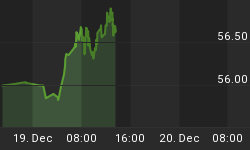There is no doubt that the S&P 500 has made new all-time highs. So has the Dow Jones Industrials (DJI) and the Dow Jones Transportations (DJT). The NASDAQ has not. Gold made new all-time highs back in September 2011. Despite the elation over the new all-time highs, none of them have really made all-time highs. How can that be? What the S&P 500, the DJI, the DJT and gold did was make new all-time nominal highs. With the exception of the DJT, none of the above has made new all-time highs on an inflation-adjusted basis. Oil made new all-time highs on an inflation-adjusted basis when it soared to $147 back in 2008. Gold, the DJI and the S&P 500, however, remain non-confirming of new highs.
Somewhat similar patterns emerge when one looks at the above in terms of other currencies as well. Expressed in Euros the S&P 500 and the DJI have not made new highs. The DJT and Gold did. Similar patterns emerge when looking at the indices and gold in terms of other currencies as well.
I will present only the S&P 500 here. These non-confirmations can act as a warning sign that something might be amiss. In hindsight, gold's failure to make new all-time highs on an inflation-adjusted basis back in 2011 turned out to be a non-confirmation warning sign. Everyone was wrapped up in the nominal new highs. It is possible that the failure of the S&P 500 to confirm its nominal highs (so far) could also be sending a warning. None of that is to suggest that the S&P 500 might not eventually confirm its nominal highs but until it is confirmed some caution should be exercised given the run that the index has had thus far in 2013.
The S&P 500 has soared almost 26% thus far in 2013. The last time the S&P 500 was seeing those elevated gains was in the go-go 1990's. Everyone knows how that one ended. Back then, GDP growth was generally double what is being seen today.

Charts created using Omega TradeStation 2000i. Chart data supplied by Dial Data
This first chart shows the S&P 500 (nominal). This is how everyone is used to viewing the S&P 500. On a nominal basis, the current market is well above both the highs seen in 2000 and in 2007. The 2007 highs were barely above the highs of 2000. The current market is roughly 15% above the highs of both 2000 and 2007.
When viewed from the Euro zone the performance has not been very good. Expressed in Euros the S&P 500 is currently about 24% below the highs of 2000 although in Euros it is about 15% above the highs of 2007. If markets are to confirm each other the S&P 500 should be making new highs in Euros as well. The failure of the S&P 500 to make new highs in Euros is a reflection of the decline of the US$ versus the Euro since 2000.

Charts created using Omega TradeStation 2000i. Chart data supplied by Dial Data
The second chart shows the S&P 500 expressed in Japanese Yen and in Cdn$. The S&P 500 in Japanese Yen has exceeded the highs of 2000 currently by about 8%. However, expressed in Japanese Yen the S&P 500 is still about 3% below the highs of 2007. Helping the S&P 500 regain the 2007 highs in Japanese Yen has been the 25% decline in the value of the Yen against the US$ over the past two years.
With the Cdn$ rising from a value under 64 back in 2002 to its current level near 94 (the Cdn$ hit a high of 110 in 2007) the S&P 500 expressed in Cdn$ has underperformed. The recent decline in the value of the Cdn$ has helped the S&P 500 in Cdn$ soar past the 2007 high but it remains about 15% below the 2000 high. Currently the S&P 500 in Cdn$ is about 12% above the 2007 highs. As with the S&P 500 expressed in Euros this is a non-confirmation of the nominal all-time highs being made by the S&P 500.

Charts created using Omega TradeStation 2000i. Chart data supplied by Dial Data
The final chart shows the S&P 500/Gold ratio and the S&P 500 adjusted for inflation. The past two years has seen the S&P 500/Gold ratio rise about 145%. However, expressed in gold the S&P 500 is down 74% from the highs seen in 2000. Despite the fall in gold prices over the past two years coupled with the rise in the S&P 500 overall, gold has remained the superior investment since 2000.
On an inflation-adjusted basis, the S&P 500 is back where it was in 2007 but remains 14% below the highs of 2000. The non-confirmation of the S&P 500 on an inflation-adjusted basis may be the most important indication that the index has not yet made new highs.
Until the S&P 500 can make new all-time highs on an inflation-adjusted basis it may be an indicator that there is another downside move to come before that can happen. During the last bear market 1966-1982, the final low for the DJI 1982 on an inflation-adjusted basis was at levels equivalent with the lows seen from 1937-1948. It took until 1995 for the DJI to take out the highs of 1966 on an inflation-adjusted basis.
Technical analysis suggests that real bull markets occur when the markets are not only making new nominal highs but also making new highs in currencies, gold and on an inflation-adjusted basis. Currently that is not happening. Investors should be wary.















